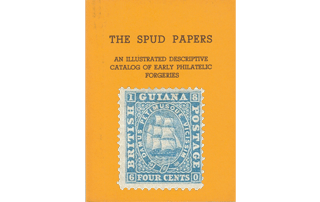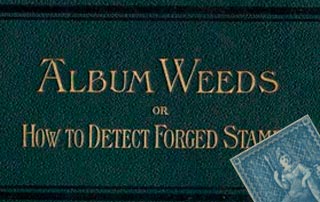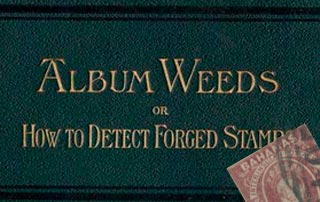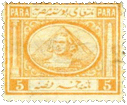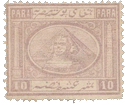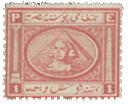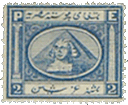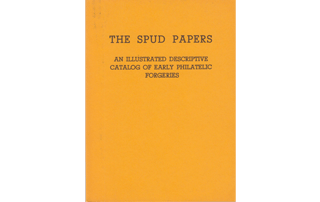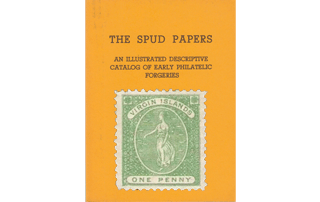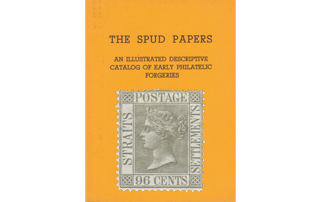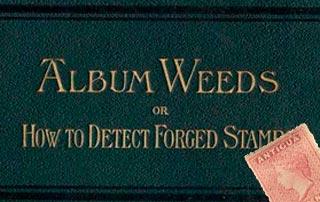 One Penny, red, carmine, etc.
One Penny, red, carmine, etc.
The varieties of the 1d. are: 1859, no watermark, imperf., lake. 1861, no watermark, clean-cut perf. 14 to 16; also rough perf. 14 to 16, lake. Perf. 11 1/2 to 12, no watermark, carmine-lake. Perf. 13, no watermark, brown-lake, carmine-lake. 1863-75, CC, perf. 12 1/2, brown-lake, carmine-lake, rose-red, vermilion. CC, perf. 14, vermilion. 1882, CA, perf. 12, vermilion. C A, perf. 14, vermilion.
I have given the above list of the different issues of the penny stamp, so as to assist in the detection of any future forgeries which may appear; but the originals are so very pretty, and so nicely executed, that there is not much fear of any of the forgeries being dangerous. Before I say anything about the counterfeit now to be described, perhaps I had better mention a fact which some of my readers have, no doubt, by this time, found out for themselves; and that is, that these penny stamps will not stand the application of water. I have seen some most doleful-looking specimens occasionally, in the albums of amateurs who were not aware of this peculiarity.
I would recommend, therefore, that, to remove any backing off these stamps, they should be floated on water with the face uppermost, care being taken that no single drop touches the face; and when they are thoroughly moist, the back will come off without difficulty. This is the way I always treat my own stamps, and I never get the faces wet, and thus do not damage them.
Genuine
Engraved in taille-douce, perforation and watermark as above, according to the issue. The shading of the oval behind the head is composed of crossed lines; but the vertical lines
are slightly more prominent than the horizontal ones. The face is shaded all over, except just along
the ridge of the nose, and on the forehead, between the eyebrows; the neck is also shaded all over.
The highest leaf of the top tuft of the pine-apple touches the top of its containing-oval. The top of
the conch-shell in the oval on the other side of the stamp also touches the top of its containing-oval.
There are two lines of shading on the ribbon, immediately before the first letter of INTERINSULAR, and two similar lines immediately after the last letter of POSTAGE. The border of the stamp is a dark strip of engine-turning; and immediately inside this is more engine-turning, but of a lighter and more lace-like pattern, not so heavily colored. There are twenty-seven jewels in the lowest row of the crown, resting upon the hair.
Forged
Lithographed, on stout, yellowish-white wove paper, pin-perforated 13, no watermark. The shading of the oval behind the head is of vertical lines only. All the central portion of the face is unshaded ; and the centre of the bottom of the neck is also white. The highest leaf of the tuft of the pine-apple does not touch the top of the little oval; nor does the top of the conch-shell touch the top of its oval either. There are no lines of shading on the ribbon, either immediately before or after the inscription. My readers must please understand that I do not refer to the folded part of the ribbon, as this is shaded on the right side in both genuine and forged; but I simply speak of the flat portion of it, which contains the words INTERINSULAR POSTAGE. The border of the stamp is pretty fairly imitated ; but the beautiful lace-work just inside the border is, in these forgeries, represented by heavy and clumsy blotches and masses of color. It is usually impossible to count the lowest row of jewels of the crown, resting upon the hair; as, on the right side of the head (i.e., on the left side of the stamp), they run together into a white line; but a good copy of this forgery shows about thirty or thirty-one jewels in the lowest row.

 Issue of 1861. Fourpence, rose; Sixpence, grey, mauve.
No watermark. Perforated 14, 13, 12.
Issue of 1861. Fourpence, rose; Sixpence, grey, mauve.
No watermark. Perforated 14, 13, 12.
Issue of 1862-3. Watermark Crown and CO. Perforated 12 1/2, 14.
Issue of 1882. (The Fourpence.) Watermark Crown and CA. Perforated 14.
Genuine
Engraved in taille-douce, on stout, white wove paper; both values from the same die. The background, outside the central oval, is composed of strips of engine-turning, in two patterns, placed alternately; and each alternate strip, beginning with the outer one on each side, has a row of diamond-shaped dots running down the center of it. None of the stars in the four corners of the stamp touch their containing squares anywhere, and they are all exactly alike. The central oval, behind the bust, is formed of very fine crossed, vertical and horizontal lines; but I ought to mention here that I have a copy of the 6d. of 1861 which certainly appears to have a solid background However, it is possible that the paper may have been too damp, causing the fine lines to run into each other. There are eighteen or nineteen pearls in the necklace ; and the central one, which has a dark spot in the middle of it, is very much larger than any of the others. The base of the crown has two rows of pearls, with a row of diamonds or some other jewels between them. The upper outline of the value-label does not encroach upon the ribbon which contains the word POSTAGE. The whole stamp is very delicately engraved. The Queen’s lips are parted slightly, as though she were just going to speak.
First Forgery
Lithographed, on stout, very yellowish-white wove paper, no water- mark, unperforated, and perforated 11 1/2 and 12, better than usual. The dots on the alternate strips of engine-turning are of various shapes, but most of them are round, and none of them diamond-shaped. One point of each of the lower stars usually touches the outline of its containing- square somewhere; and the lower stars are generally badly done, and not like the upper ones. The central oval behind the bust is composed of crossed lines, like the genuine ; but they are blotchy, coarse, and indistinct, very different from the genuine. There are thirteen pearls in the necklace. These pearls are not nicely graduated in size, as the genuine are ; and the one with the dark spot in the center of it is not so large as the one immediately to the left of it. The base of the crown is formed of three rows of pearls, the central row being just the same as those above and below it. The bottom of the ribbon containing the word POSTAGE is cut into by the straight value-label below it, so that the S and T of that word (especially in the Fourpence) have to be made a little smaller than the rest of the letters. The whole stamp has a coarse look; and the Queen’s lips are far too wide open, so that she looks as though about to scream, rather than speak.
Second Forgery
Lithographed, on very yellowish-white wove paper, rather stout, badly pin-perforated 12 1/2 no watermark. I never saw this forgery before about 1890. The dots in the vertical strips of engine-turning are diamond- shaped, as in the genuine ; but each of the dark diamonds is placed in the center of a white diamond. The corner-squares, with their stars, are not alike in shape and size, the star and square in the left top corner, especially, being much smaller than those in the right top corner. The Fourpence has the background behind the bust apparently solid, but the Sixpence has the crossed, vertical and horizontal lines very distinct, though they lack the beautiful regularity of the genuine. There are fifteen pearls in the necklace, and nine of them contain spots; the four large ones in front having apparently two in each, though they require the microscope to make them out distinctly. The easiest test for this forgery is, I think, the second vertical strip of engine-turning on each side. In the genuine, these two strips are a fine and beautiful lace-work, and in each strip there is a horizontal row of very tiny, diamond-shaped dots (five in each, where the central oval does not encroach upon them) level with the larger, single, diamond-shaped dots in the first and third strips, as described above. In this forgery, the second strip from the outside, on each side of the stamp, is a mere meaningless jumble of blotches and scratches, spoiling the effect of the stamp completely. The outline of the lower jaw, on the right side of the stamp, forms almost a straight line from the chin to the ear; in the genuine, this is a nice and well modeled curve. Thus the Queen seems to have an altogether unnaturally hollow cheek. The lettering in this second forgery is a good deal thinner than in the genuine or in the first forgery.
 One Shilling, green.
Issue of 1862-3 and 1882.
One Shilling, green.
Issue of 1862-3 and 1882.
The design, paper, and manner of printing of this stamp are all considerably different from those of the stamps just described; and I think that, on the whole, the forgers have not been quite so successful in this as in the lower values. However, my readers must judge for themselves.
Genuine
Engraved in épargne, perforation and watermark as above, on slightly glacé paper. The stamp, though not particularly striking, is very carefully engraved. The face is shaded almost all over, though there is a small, unshaded portion at the corner of the nose, and another at the top of the forehead. The ear is all shaded, except the tip, which hangs down a little. Just under the middle A of BAHAMAS, there is a small circle or ring, with another circle in the center of it. The conch- shell in the right lower corner has a sharp spike projecting from the right-hand side, about the center, and another from the left-hand side, at the bottom. There are five leaves at the base of the pine-apple, and five more in the bunch at the top. If a straight line were drawn down through the center of the pine-apple, it would cut into the 0 of ONE, considerably to the right of its center. The white space round the central medallion is equally broad all round, and the outline of the portrait does not trespass upon this white space anywhere. There is a tiny full-stop after the Etruscan bordering to the right, above the G of SHILLING; and the upper horizontal stroke of the last key in this pattern is wanting, as the border cuts it off.
Forged
Lithographed, on ordinary, white wove paper, unperforated, or pin-perforated 13, no watermark, ungummed. The front of the face, from the forehead to the chin, has hardly any shading upon it. The rim of the ear is white, and the lobe of it inclines forward instead of downward. The letters of the name BAHAMAS are clumsily copied, and the circle under the middle A has a dot in the center of it. The spikes on the conch-shell are absent. There are only four leaves at the base of the pine-apple, and the leaves on the top cannot be counted. A line drawn down through the center of the pine-apple would cut exactly through the center of the O of ONE. The white space round the inside of the central medallion is much broader in some parts than others; notably under the MA of BAHAMAS, and below the base of the neck. The chignon, and the pointed front of the neck, project slightly into this white space. There is no stop at the right-hand end of the Etruscan or key-pattern, and the last key over the G of SHILLING is only a straight line. The base of the defective key over the S of SHILLING is much longer than the bases of the others; whereas, in the genuine, it is of the same length as the rest.
 Issue of 1883. Fourpence (Provisional), mauve and black.
Watermark Crown and CC. Perforated 12 1/2 and 14.
Issue of 1883. Fourpence (Provisional), mauve and black.
Watermark Crown and CC. Perforated 12 1/2 and 14.
This is the Sixpence before described, with the value FOURPENCE, as here illustrated, surcharged on it in black. It will be understood that the forgers have taken the genuine Sixpence, only the surcharge being counterfeited.
Genuine
The lettering is in thick, rather clumsy and blotchy Roman capitals, 2 1/4 mm. high. It is all in one word—FOURPENCE—and so wide that there is scarcely room for it on the stamp. From the center of the upright stroke of the F to the center of the upright stroke of the last E, the distance is 17 1/2 mm. The lettering is deeply sunk into the paper. From the center of the upright stroke of the R to the center of the upright stroke of the P, the distance is just a shade over 2 mm.
Forged
The lettering is not nearly so thick and clumsy as in the genuine, and the letters are exactly 2 mm. high. The surcharge is in two distinct words—FOUR PENCE—and there is a stop after PENCE. There is room for the surcharge and the stop on the stamp. From the center of the upright stroke of the F to the center of the upright stroke of the last E, the distance is 16 1/4 mm. The lettering is hardly, if at all, sunk into the paper. From the center of the upright stroke of the R to the center of the upright stroke of the P, the distance is 3 1/2 mm. I think the above measurements will suffice for the detection of this forgery.
Postmarks
Genuine.—1, 54 ; also the same, with a large B in the center; also pen-strokes; also the date written in pen-and-ink, like the cancellation on an English receipt stamp. (This last is probably a fiscal cancellation.)
Forged.—6 (no numerals), 22, 33, 54, 62. As to the surcharged Four-pence, this, of course, bears the genuine cancellations, but under, not over, the surcharge.
From: ‘Album Weeds’, 3rd edition by R. B. Eareé. 1906
 See also —> Spud Papers – Bahamas
See also —> Spud Papers – Bahamas



 1860. 1, 2, 4, 8, 12 and 24 Cents.
1860. 1, 2, 4, 8, 12 and 24 Cents.![]() See also –> Album Weeds – British Guiana
See also –> Album Weeds – British Guiana
